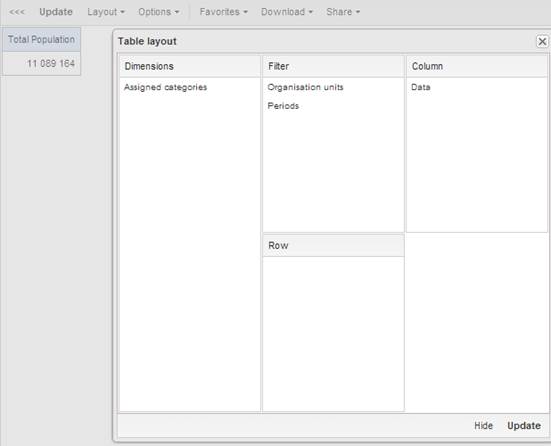In my case it is definitely the averaging over both periods and orgunits which is most critical, the other ones are more “nice to have”.
A backporting to 2.16 would be highly appreciated if possible.
···
From: Lars Helge Øverland [mailto:larshelge@gmail.com]
Sent: 07 September 2014 16:24
To: Rodolfo Melia
Cc: Robin Martens; dhis2-users; dhis2-devs@lists.launchpad.net
Subject: Re: [Dhis2-devs] DHIS2 - Averaging over orgunits
Hi there,
we will try to get it in for 2.17.
One question around the design: We currently have 7 aggregation operators:
sum | average | count | std dev | variance | min | max
Re individual aggregation operators for the time and org unit dimension, from a technical perspective we are not first aggregating in time, then in org unit dimension, rather aggregating it all in a single query to achieve good performance.
Allowing for 7 x 7 = 49 possible combinations of aggregation operators will be complex to implement and some combinations might not be meaningful. I am sensing that it is doing average across both time and org unit which is the most useful combination we currently lack. Implementing this will be straight-forward and could even be back-ported to 2.16.
So the question is: Will it be sufficient to come up with the most useful pre-defined combinations of time and org unit aggregation operators, or do we need to have full flexibility and allow all aggregation operators in both dimensions?
If the former then please suggest which combinations are most useful.
Already on the list:
Sum
Average
Org unit: Average - Time: Sum
Org unit: Sum - Time: Average
Count
Std dev
Variance
Min
Max
regards,
Lars
On Sun, Sep 7, 2014 at 2:10 AM, Rodolfo Melia rmelia@knowming.com wrote:
Hi - i just want to add support to the importance of splitting the aggregator operator across time and org units. I’m planning around its availability for 2.17
Rodolfo Meliá
On 5 Sep 2014, at 17:26, Robin Martens martens@sher.be wrote:
Hi Lars,
Thank you. I thought so but couldn’t find the reference.
In the blueprint it is assigned to release 2.17, is this still being maintained?
Regards,
Robin
From: Lars Helge Øverland [mailto:larshelge@gmail.com]
Sent: 05 September 2014 18:24
To: Robin Martens
Cc: dhis2-users;
dhis2-devs@lists.launchpad.net
Subject: Re: DHIS2 - Averaging over orgunits
Hi Robin,
I get your point. This has actually been raised before and we plan to support individual aggregation operators for the org unit and time dimensions. Blueprint here:
https://blueprints.launchpad.net/dhis2/+spec/orgunit-hierarchy-aggregation-operator
regards,
Lars
On Thu, Sep 4, 2014 at 12:49 PM, Robin Martens martens@sher.be wrote:
Hi there,
As per the manual, the “average” option when defining data elements aggregates by average over periods but sum over orgunits. This limits severely the reporting possibilities, for instance when calculating the average person age over multiple districts but I can think of many other examples (prices, age, education grades,…). Is there any way to configure DHIS2 to average over orgunits?
Thank you,
Robin
Mailing list: https://launchpad.net/~dhis2-devs
Post to : dhis2-devs@lists.launchpad.net
Unsubscribe : https://launchpad.net/~dhis2-devs
More help : https://help.launchpad.net/ListHelp

